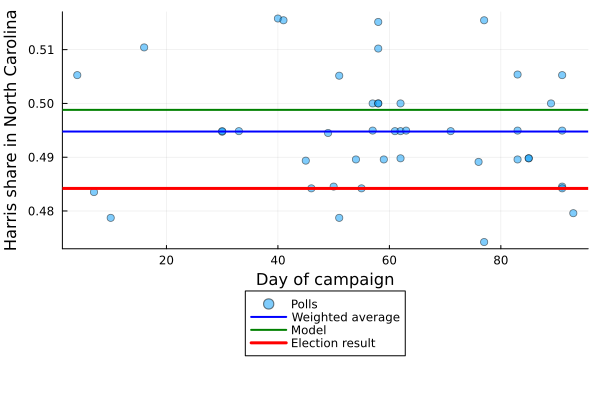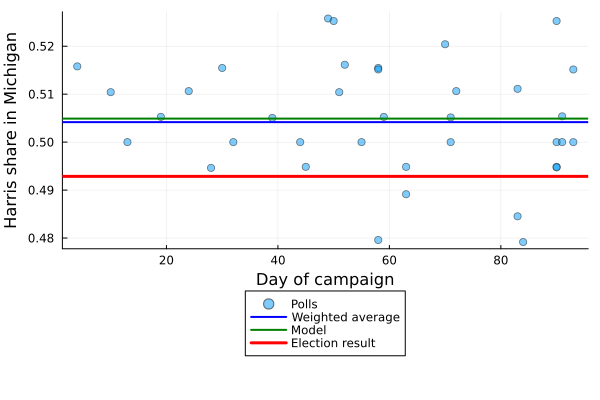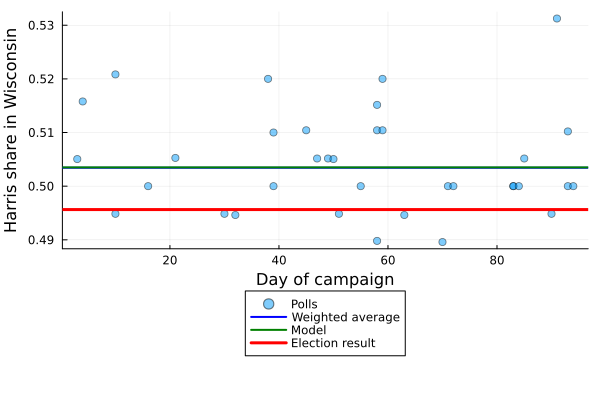Harris was likely to have won Pennsylvania, Michigan and Wisconsin and, speculatively, Nevada if the model corresponded to the election results. This would have resulted in a 270-268 win, assuming no changes from the 2020 election in other states and electoral districts. Trump would have won the remaining states.
The number of "likely voter" polls increased substantially in the second half of September. As a result, the model was revised to excluded "registered voter" surveys and to include all likely voter polls from August to late September. As before, the beginning assumptions include a close contest in the range of Harris taking between 48% and 52% of vote in each swing state. This is a "strong" prior and pronounced polling results will be required to move the credible interval outside that range. The model is based on the Bayesian analysis described in Methodology.
More new polling than was anticipated before the election prompted this final update.
Harris lost all of the swing states.
In Arizona 21 pollsters conducted a total of 37 polls from Jul 30 to Oct 31. Overall, the weighted mean poll of 49.17% indicated a victory for Trump over Harris in the two-candidate race. Weights were assigned by number of respondents. Of the pollsters, 17 corresponded to a victory for Trump with 50.83% of the two-candidate vote. The other 4 corresponded to a victory for Harris in the two-candidate vote, overstating her actual share, which was 47.22%.

| Atlas Intel |
49.25% |
| Bloomberg |
50.78% |
| CBS News |
48.48% |
| CNN* |
49.03% |
| Cook Political Report |
51.04% |
| Data Orbital |
45.65% |
| Emerson |
48.45% |
| FOX News |
48.48% |
| Fabrizio/Anzalone |
48.98% |
| GSG/NSOR |
50.53% |
| InsiderAdvantage |
49.14% |
| KPHO-TV/HighGround |
51.06% |
| Marist |
49.49% |
| NY Times/Siena |
49.01% |
| Noble Predictive Insights |
49.47% |
| PPP (D) |
48.96% |
| Rasmussen Reports |
48.93% |
| The Hill/Emerson |
48.99% |
| Trafalgar Group (R |
49.47% |
| Trafalgar Group (R) |
49.11% |
| USA Today/Suffolk |
46.67% |
| JUL |
48.96% |
| AUG |
49.47% |
| SEP |
49.35% |
| OCT |
48.92% |
In Georgia 17 pollsters conducted a total of 31 polls from Jul 30 to Oct 30. Overall, the weighted mean poll of 49.10% indicated a victory for Trump over Harris in the two-candidate race. Weights were assigned by number of respondents. Of the pollsters, 13 corresponded to a victory for Trump with 50.90% of the two-candidate vote. The other 4 corresponded to a victory for Harris in the two-candidate vote, overstating her actual share, which was 48.89%.

| AmGreatness/TIPP |
50.00% |
| Atlanta Journal-Constitution |
48.35% |
| Atlas Intel |
49.24% |
| Bloomberg |
49.49% |
| CBS News |
49.00% |
| CNN* |
49.47% |
| Cook Political Report |
49.48% |
| FOX News |
51.52% |
| Fabrizio/Anzalone |
50.00% |
| InsiderAdvantage |
49.65% |
| Marist |
49.74% |
| NY Times/Siena |
47.89% |
| PPP (D) |
50.53% |
| Quinnipiac |
47.51% |
| Rasmussen Reports |
48.00% |
| The Hill/Emerson |
49.42% |
| Trafalgar Group (R) |
49.28% |
| JUL |
50.28% |
| AUG |
49.64% |
| SEP |
49.09% |
| OCT |
48.82% |
In Nevada 16 pollsters conducted a total of 26 polls from Aug 2 to Oct 31. Overall, the weighted mean poll of 49.75% indicated a victory for Trump over Harris in the two-candidate race. Weights were assigned by number of respondents. Of the pollsters, 8 corresponded to a victory for Trump with 50.25% of the two-candidate vote. The other 8 corresponded to a victory for Harris in the two-candidate vote, overstating her actual share, which was 48.42%.

| AmGreatness/TIPP |
49.49% |
| Atlas Intel |
48.22% |
| Bloomberg |
48.31% |
| CNN* |
49.47% |
| Cook Political Report |
50.54% |
| Emerson |
50.53% |
| GSG/NSOR |
50.53% |
| InsiderAdvantage |
50.01% |
| NY Times/Siena |
50.53% |
| Noble Predictive Insights |
49.47% |
| Rasmussen Reports |
50.25% |
| Susquehanna |
46.81% |
| TTrafalgar Group (R) |
50.55% |
| The Hill/Emerson |
49.96% |
| Tie Trafalgar Group (R) |
49.44% |
| Trafalgar Group (R) |
50.28% |
| AUG |
50.33% |
| SEP |
49.36% |
| OCT |
49.76% |
In North Carolina 26 pollsters conducted a total of 44 polls from Aug 2 to Oct 30. Overall, the weighted mean poll of 49.48% indicated a victory for Trump over Harris in the two-candidate race. Weights were assigned by number of respondents. Of the pollsters, 17 corresponded to a victory for Trump with 50.52% of the two-candidate vote. The other 9 corresponded to a victory for Harris in the two-candidate vote, overstating her actual share, which was 48.28%.

| AmGreatness/TIPP |
48.42% |
| Atlas Intel |
47.96% |
| Bloomberg |
50.29% |
| CNN |
50.00% |
| CNN* |
50.53% |
| Carolina Journal/Cygnal |
48.35% |
| Carolina Journal/Cygnal* |
49.45% |
| Cook Political Report |
50.26% |
| East Carolina U. |
48.96% |
| East Carolina U.* |
49.47% |
| Emerson |
49.22% |
| FOX News |
49.49% |
| Fabrizio/Anzalone |
48.45% |
| High Point University |
50.00% |
| High Point/SurveyUSA |
50.54% |
| InsiderAdvantage |
49.31% |
| Marist |
49.51% |
| NY Times/Siena |
49.98% |
| Quinnipiac |
50.87% |
| Rasmussen Reports |
48.08% |
| The Hill/Emerson |
49.86% |
| Tie Atlas Intel |
51.52% |
| Trafalgar Group (R) |
48.55% |
| Victory Insights |
47.87% |
| WRAL-TV/SurveyUSA |
50.81% |
| Washington Post |
48.98% |
| AUG |
49.32% |
| SEP |
49.72% |
| OCT |
49.23% |
In Pennsylvania 25 pollsters conducted a total of 51 polls from Jul 30 to Oct 30. Overall, the weighted mean poll of 50.02% indicated a victory for Harris over Trump in the two-candidate race. Weights were assigned by number of respondents. Of the pollsters, 11 corresponded to a victory for Trump. The other 14 corresponded to a victory for Trump in the two-candidate vote, but overstating the actual share for Harris., 48.42%.

| AmGreatness/NSOR |
50.00% |
| AmGreatness/TIPP |
49.48% |
| Atlas Intel |
48.98% |
| Bloomberg |
51.82% |
| CBS News |
50.00% |
| CNN* |
50.00% |
| Cook Political Report |
50.51% |
| Emerson |
49.66% |
| FOX News |
49.71% |
| Fabrizio/Anzalone |
51.55% |
| Franklin & Marshall |
49.49% |
| InsiderAdvantage |
49.22% |
| Marist |
50.50% |
| Muhlenberg College |
50.00% |
| NY Times/Siena |
51.91% |
| PPP (D) |
49.47% |
| Quinnipiac |
50.80% |
| Rasmussen Reports |
49.27% |
| Susquehanna |
50.00% |
| The Hill/Emerson |
49.65% |
| Trafalgar Group (R) |
48.72% |
| UMass Lowell |
51.06% |
| USA Today/Suffolk |
50.79% |
| Washington Post |
50.29% |
| co/efficient |
48.94% |
| JUL |
49.47% |
| AUG |
50.04% |
| SEP |
50.22% |
| OCT |
49.83% |
In Michigan 21 pollsters conducted a total of 37 polls from Aug 2 to Oct 30. Overall, the weighted mean poll of 50.42% indicated a victory for Harris over Trump in the two-candidate race. Weights were assigned by number of respondents. Of the pollsters, 5 corresponded to a victory for Trump with 49.58% of the two-candidate vote going to Harris//t//. The other 16 corresponded to a victory for Harris in the two-candidate vote, overstating her actual share, 49.29%.

| Cook Political Report |
51.55% |
| InsiderAdvantage |
50.27% |
| Fabrizio/Anzalone |
50.26% |
| Rasmussen Reports |
50.26% |
| AmGreatness/TIPP |
51.06% |
| EPIC-MRA |
49.46% |
| The Hill/Emerson |
50.82% |
| Trafalgar Group (R) |
50.01% |
| CBS News |
50.51% |
| MIRS/MI News Source |
49.72% |
| Quinnipiac |
49.98% |
| Marist |
52.00% |
| USA Today/Suffolk |
50.81% |
| Atlas Intel |
49.09% |
| Bloomberg |
50.04% |
| NY Times/Siena |
50.53% |
| quinnipiac |
52.04% |
| Emerson |
49.48% |
| Susquehanna |
52.53% |
| FOX News |
50.00% |
| Washington Post |
50.54% |
| AUG |
50.61% |
| SEP |
50.51% |
| OCT |
50.25% |
In Wisconsin 17 pollsters conducted a total of 35 polls from Aug 1 to Oct 31. Overall, the weighted mean poll of 50.34% indicated a victory for Harris over Trump in the two-candidate race. Weights were assigned by number of respondents. Of the pollsters, 4 had a weighted mean average that corresponded to a victory for Trump with only 49.66% of the two-candidate vote going to Harris. The other 13 corresponded to a victory for Harris with 50.88% in the two-candidate vote, overstating her actual share, which was only 49.56%.

| Marquette |
51.49% |
| Cook Political Report |
51.31% |
| InsiderAdvantage |
50.00% |
| NY Times/Siena |
51.56% |
| AmGreatness/TIPP |
50.00% |
| Rasmussen Reports |
50.27% |
| The Hill/Emerson |
49.67% |
| Trafalgar Group (R) |
49.64% |
| CBS News |
51.00% |
| ieo/efficient |
50.00% |
| Fabrizio/Anzalone |
50.52% |
| Quinnipiac |
49.83% |
| Marist |
50.78% |
| Atlas Intel |
49.37% |
| Bloomberg |
50.83% |
| Emerson |
50.52% |
| CNN* |
53.12% |
| AUG |
50.23% |
| SEP |
50.49% |
| OCT |
50.23% |






